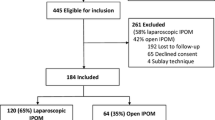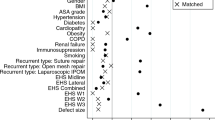Abstract
Introduction
Incisional hernias are associated with a reduced quality of life. Mesh reinforcement of the abdominal wall is the current standard for incisional hernia repair (IHR), since it reduces the risk of recurrence. The best position for the mesh remains controversial, and each position has advantages and disadvantages.
Objective
In this nationwide population-based study, we aimed to determine whether IHR with intraperitoneal mesh is associated with an increased risk of bowel obstruction.
Patients and methods
Using the French hospital database (PMSI), which collects data from all public and private hospitals, two patient cohorts were created and compared. Patients having undergone a laparoscopic IHR with intraperitoneal mesh (IPOM) in 2013 or 2014 due to a laparotomy performed in the 4 previous years were the IPOM group. Patients hospitalized for any other acute disease (i.e., without IHR) in 2013 and 2014, but having a similar laparotomy in the 4 previous years were the control group. Both cohorts were followed until 2019 in search of any episode of bowel obstruction.
Results
A total of 815 patients were included in the IPOM group and matched to 1630 control patients. The 5 year bowel obstruction rate was 7.36% in the IPOM group and 4.42% in the control group (p < 0.01). In the multivariate analysis, after adjustment on age and obesity, incisional hernia repair with laparoscopic IPOM increased the risk of bowel obstruction in the 5 years following surgery (HR = 1.712; 95% CI 1.208–2.427; p = 0.0025).
Conclusions
Patients having undergone laparoscopic IPOM have an increased risk of bowel obstruction compared with patients who have a similar surgical history but no IHR.


Similar content being viewed by others
Data availability
PMSI data are available for researchers who meet the criteria for access to these French confidential data. Access is submitted to the approval of the National Committee for data protection (CNIL) and from the national agency for the management of hospitalization (ATIH–Agence Technique de l'Information sur l'Hospitalisation). According to the French law, no individual informed consent was required for this study. All data used in this analysis were anonymous and no personal medical records were consulted.
References
Al Chalabi H, Larkin J, Mehigan B, McCormick P (2015) A systematic review of laparoscopic versus open abdominal incisional hernia repair, with meta-analysis of randomized controlled trials. Int J Surg 20:65–74. https://doi.org/10.1016/j.ijsu.2015.05.050
Gignoux B, Bayon Y, Martin D, Phan R, Augusto V, Darnis B et al (2021) Incidence and risk factors for incisional hernia and recurrence: retrospective analysis of the French national database. Colorectal Dis 23:1515–1523. https://doi.org/10.1111/codi.15581
Itatsu K, Yokoyama Y, Sugawara G, Kubota H, Tojima Y, Kurumiya Y et al (2014) Incidence of and risk factors for incisional hernia after abdominal surgery. Br J Surg 101:1439–1447. https://doi.org/10.1002/bjs.9600
Ramakrishna HK, Lakshman K (2013) Intra peritoneal polypropylene mesh and newer meshes in ventral hernia repair: what EBM says? Indian J Surg 75(5):346–351. https://doi.org/10.1007/s12262-012-0743-x
Anthony T, Bergen PC, Kim LT, Henderson M, Fahey T, Rege RV et al (2000) Factors affecting recurrence following incisional herniorrhaphy. World J Surg 24:95–101. https://doi.org/10.1007/s002689910018
Kaufmann R, Halm JA, Eker HH, Klitsie PJ, Nieuwenhuizen J, van Geldere D et al (2018) Mesh versus suture repair of umbilical hernia in adults: a randomised, double-blind, controlled, multicentre trial. Lancet 391:860–869. https://doi.org/10.1016/S0140-6736(18)30298-8
Mathes T, Walgenbach M, Siegel R (2016) Suture versus mesh repair in primary and incisional hernias: a systematic review and meta-analysis. World JSurg 40:826–835. https://doi.org/10.1007/s00268-015-3311-2
Köckerling F, Hoffmann H, Mayer F, Zarras K, Reinpold W, Fortelny R et al (2021) What are the trends in incisional hernia repair? real-world data over 10 years from the herniamed registry. Hernia 25(2):255–265. https://doi.org/10.1007/s10029-020-02319-y
Sosin M, Nahabedian MY, Bhanot P (2018) The perfect plane: a systematic review of mesh location and outcomes, update 2018. American Soc Plast Surg 142:107S-116S. https://doi.org/10.1097/PRS.0000000000004864
Kokotovic D, Bisgaard T, Helgstrand F (2016) Long-term recurrence and complications associated with elective incisional hernia repair. JAMA 316:1575–1582. https://doi.org/10.1001/jama.2016.15217
Lermite E, Pessaux P, Tuech JJ, Aubé C, Arnaud JP (2004) Adhérences viscérales après cure d’éventration par plaque intrapéritonéale : étude monocentrique comparant un renfort conventionnel (Mersilène®) à un renfort composite (Parietex®). Ann Chir 129:513–517. https://doi.org/10.1016/j.anchir.2004.09.004
Fuziy RA, Artigiani Neto R, Caetano Junior EM, Alves AKS, Lopes Filho GJ, Linhares MM (2019) Comparative study of four different types of intraperitoneal mesh prostheses in rats. Acta Cir Bras 34(7):E201900703. https://doi.org/10.1590/s0102-865020190070000003
Tuppin P, Rudant J, Constantinou P, Gastaldi-Ménager C, Rachas A, de Roquefeuil L et al (2017) Value of a national administrative database to guide public decisions: from the système national d’information interrégimes de l’Assurance Maladie (SNIIRAM) to the système national des données de santé (SNDS) in France. Epidemiol Public Health 65:S149–S167. https://doi.org/10.1016/j.respe.2017.05.004
Piroth L, Cottenet J, Mariet AS, Bonniaud P, Blot M, Tubert-Bitter P et al (2021) Comparison of the characteristics, morbidity, and mortality of COVID-19 and seasonal influenza: a nationwide, population-based retrospective cohort study. Lancet Respir Med 9:251–259. https://doi.org/10.1016/S2213-2600(20)30527-0
Magnin J, Bernard A, Cottenet J, Lequeu JB, Ortega-Deballon P, Quantin C et al (2023) Impact of hospital volume in liver surgery on postoperative mortality and morbidity: nationwide study. Br J Surg 110(4):441–448. https://doi.org/10.1093/bjs/znac458
Itani KMF (2010) Comparison of laparoscopic and open repair with mesh for the treatment of ventral incisional hernia: a randomized trial. Arch Surg 145(4):322. https://doi.org/10.1001/archsurg.2010.18
Eker HH, Hansson BME, Buunen M, Janssen IMC, Pierik REGJM, Hop WC et al (2013) Laparoscopic versus open incisional hernia repair: a randomized clinical trial. JAMA Surg 148:259–263. https://doi.org/10.1001/jamasurg.2013.1466
Fortelny RH, Petter-Puchner AH, Glaser KS, Offner F, Benesch T, Rohr M (2010) Adverse effects of polyvinylidene fluoride-coated polypropylene mesh used for laparoscopic intraperitoneal onlay repair of incisional hernia. Br JSurg 97:1140–1145. https://doi.org/10.1002/bjs.7082
Briennon X, Lermite E, Meunier K, Desbois E, Hamy A, Arnaud JP (2011) Surgical treatment of large incisional hernias by intraperitoneal insertion of Parietex® composite mesh with an associated aponeurotic graft (280 cases). J Visc Surg 148:54–58. https://doi.org/10.1016/j.jviscsurg.2010.12.007
Arung W, Meurisse M, Detry O (2011) Pathophysiology and prevention of postoperative peritoneal adhesions. World J Gastroenterol 17:4545–4554. https://doi.org/10.3748/wjg.v17.i41.4545
Santos Filho dos PV, Santos RS, Leão SC, Duarte IX, Lima SO (2020) Experimental evaluation of intra-abdominal adhesions comparing two different intraperitoneal meshes and the effect of a natural anti-inflammatory product on their formation. Acta Cir Bra 35(12):351205. https://doi.org/10.1590/acb351205
Sharma A, Chowbey P, Kantharia NS, Baijal M, Soni V, Khullar R (2018) Previously implanted intra-peritoneal mesh increases morbidity during re-laparoscopy: a retrospective, case-matched cohort study. Hernia 22(2):343–351. https://doi.org/10.1007/s10029-017-1686-8
Patel PP, Love MW, Ewing JA, Warren JA, Cobb WS, Carbonell AM (2017) Risks of subsequent abdominal operations after laparoscopic ventral hernia repair. Surg Endosc 31(2):823–828. https://doi.org/10.1007/s00464-016-5038-z
Ten Broek RPG, Issa Y, van Santbrink EJP, Bouvy ND, Kruitwagen RFPM, Jeekel J et al (2013) Burden of adhesions in abdominal and pelvic surgery: systematic review and met-analysis. BMJ 347:f5588–f5588. https://doi.org/10.1136/bmj.f5588
Reynvoet E, Deschepper E, Rogiers X, Troisi R, Berrevoet F (2014) Laparoscopic ventral hernia repair: is there an optimal mesh fixation technique? a systematic review. Arch Surg 399(1):55–63. https://doi.org/10.1007/s00423-013-1126-x
Muysoms FE, Bontinck J, Pletinckx P (2011) Complications of mesh devices for intraperitoneal umbilical hernia repair: a word of caution. Hernia 15(4):463–468. https://doi.org/10.1007/s10029-010-0692-x
Lee Y, Bae BN (2021) Transmural mesh migration from the abdominal wall to the rectum after hernia repair using a prolene mesh: a case report. Ann Coloproctology 37(Suppl 1):S28-33. https://doi.org/10.3393/ac.2020.04.19
Turcu F, Arnăutu O, Copaescu C (2019) Adhesiolysis related challenges for laparoscopic procedures after ventral hernia repair with intraperitoneal mesh. Chirurgia 114(1):39–47. https://doi.org/10.21614/chirurgia.114.1.39
Köckerling F, Simon T, Adolf D, Köckerling D, Mayer F, Reinpold W et al (2019) Laparoscopic IPOM versus open sublay technique for elective incisional hernia repair: a registry-based, propensity score-matched comparison of 9907 patients. Surg Endosc 33(10):3361–3369. https://doi.org/10.1007/s00464-018-06629-2
Romain B, Renard Y, Binquet C, Poghosyan T, Moszkowicz D, Gillion JF, Ortega-Deballon P (2020) Recurrence after elective incisional hernia repair is more frequent than you think: an international prospective cohort from the French society of surgery. Surgery 168:125–134. https://doi.org/10.1016/j.surg.2020.02.016
Funding
This study had no specific financial support. The Regional Council of Burgundy supports in a general way the research activity of the University Hospital of Dijon. This study had no specific financial support.
Author information
Authors and Affiliations
Corresponding author
Ethics declarations
Conflict of interest
The authors have no conflict of interest to declare.
Consent to participate and consent to publish
Regarding the ‘Consent to participate’ and/or ‘Consent to publish’, this is a study based on an anonymous large-scale national database. There is no access to patients’ individual clinical records. According to the European and French regulation, patients do not need to consent nor to be informed.
Additional information
Publisher's Note
Springer Nature remains neutral with regard to jurisdictional claims in published maps and institutional affiliations.
Rights and permissions
Springer Nature or its licensor (e.g. a society or other partner) holds exclusive rights to this article under a publishing agreement with the author(s) or other rightsholder(s); author self-archiving of the accepted manuscript version of this article is solely governed by the terms of such publishing agreement and applicable law.
About this article
Cite this article
Delorme, T., Cottenet, J., Abo-Alhassan, F. et al. Does intraperitoneal mesh increase the risk of bowel obstruction? A nationwide French analysis. Hernia 28, 419–426 (2024). https://doi.org/10.1007/s10029-023-02885-x
Received:
Accepted:
Published:
Issue Date:
DOI: https://doi.org/10.1007/s10029-023-02885-x




